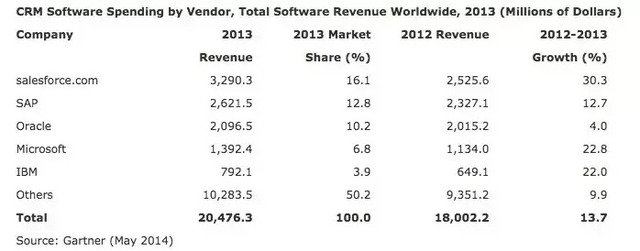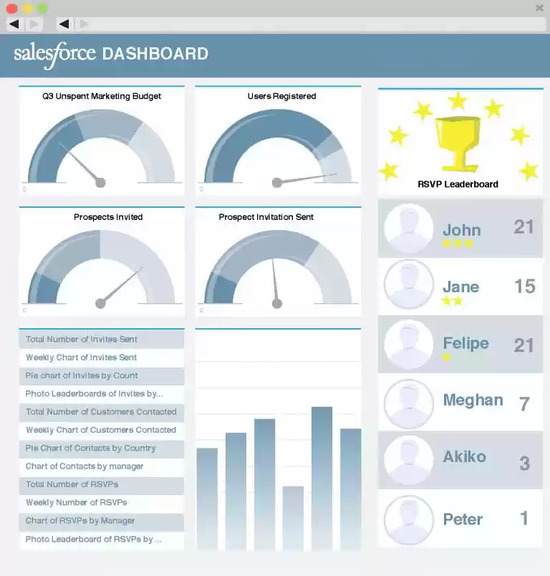CRM is customer relationship management and your business is probably using it to acquire track and help close leads. Salesforce.com defines CRM as a system that “allows businesses to manage business relationships and the data and information associated with them.” Before computers, the most popular CRM tool was known as the Rolodex. Today, CRM enterprise software supports not just one person but multiple departments and initiatives, from Marketing to Sales to Customer Success. Worldwide, CRM software grew nearly 14 percent in 2013, according to Gartner. Major players include salesforce.com, SAP, Oracle, Microsoft and IBM.  The demand for software as a service (SaaS) drove nearly half (41 percent) of the total CRM revenue in 2013 and was due to “organizations of all sizes seeking easier-to-deploy alternatives to replace legacy systems, implement net-new applications or provide alternative complementary functionality,” Gartner stated in a press release. So, how does a marketer make CRM work for them?
The demand for software as a service (SaaS) drove nearly half (41 percent) of the total CRM revenue in 2013 and was due to “organizations of all sizes seeking easier-to-deploy alternatives to replace legacy systems, implement net-new applications or provide alternative complementary functionality,” Gartner stated in a press release. So, how does a marketer make CRM work for them?
How CRMs Work for Marketers
 Data is being created every day between a business and its prospects and customers. Because of the high number of touch points, CRMs have scaled to provide a single, unified view of the customer journey. CRMs now support campaigns and customizable workflows to enable marketers to build highly automated programs. CRM today can aid in everything from customer service via social media (listening to what’s being said and responding in real time) to email marketing (sending personalized messages via email at the moment it matters) and more. These personalized touch points are going to become the norm in the future of brand communications. Aseem Chandra of Adobe argued this point in his article at Forbes, but says marketers still aren’t taking full advantage of it. CRM helps create visibility for different people in the organization, which improves collaboration and decreases account and management conflicts. All of your marketing campaigns should be set up to feed into the CRM, so you can better determine which programs and channels contribute to success or what the specific ROI of each campaign and channel is. Typically, a javascript file captures the campaign id from the url of a visitor or a lead and publishes it through the API into the CRM.
Data is being created every day between a business and its prospects and customers. Because of the high number of touch points, CRMs have scaled to provide a single, unified view of the customer journey. CRMs now support campaigns and customizable workflows to enable marketers to build highly automated programs. CRM today can aid in everything from customer service via social media (listening to what’s being said and responding in real time) to email marketing (sending personalized messages via email at the moment it matters) and more. These personalized touch points are going to become the norm in the future of brand communications. Aseem Chandra of Adobe argued this point in his article at Forbes, but says marketers still aren’t taking full advantage of it. CRM helps create visibility for different people in the organization, which improves collaboration and decreases account and management conflicts. All of your marketing campaigns should be set up to feed into the CRM, so you can better determine which programs and channels contribute to success or what the specific ROI of each campaign and channel is. Typically, a javascript file captures the campaign id from the url of a visitor or a lead and publishes it through the API into the CRM.
Implement marketing today with the following basic steps in your CRM
- Hire a CRM analyst or CRM admin
While I don’t usually like to make hiring part of the recommendations in a blog, getting value out of CRM and the reports it generates requires expertise. You should invest in training and certification for an existing staff member, hire a skilled contractor to get started or, if you can manifest the budget and req, hire a certified admin. Without that expertise, you will have trouble gaining traction and value.
- Create a campaign A CRM campaign is a collection of contacts who are being tracked and pursued at a particular time. Campaigns are so prevalent that it may be easy to miss them. Were you going to email a reminder to your customers about the dinner next week? Was your PR agency going to reach out to reporters today to promote last week’s product release? Targeting a list with a webinar message. Anything that you do to a group of people is a campaign, by definition.
- Create a consistent naming structure for your campaigns Before you amass 30 campaigns, now is the time to lay the groundwork for reporting success. Use common words, in the same pattern, across all your campaigns. For instance, you could name all your campaigns in the following pattern “[Who] [How]”. Using the examples from the previous paragraph, you would create the following campaigns “Customers Email”, “Reporters Call” and “Prospects Webinar.” This way you can report on the success of all your campaigns containing the word “Prospects” or the click through rates of all your “Email” campaigns.
- Create a dashboard It’s great to be organized by creating consistently named campaigns but don’t overlook this last but critical step. While you don’t have any results to speak of right now (because you just created the campaign and you haven’t sent the email yet or made any calls), create at least 1 report to show the number of emails, calls or whatever the activity or success metric is. Then place that 1 report in a brand new dashboard. It will look silly to have an empty dashboard showing 0 results but as the activity happens, you’ll see results flow in to your reports.
The more systematically you use CRM the more it will help you define, organize, track and distribute information about your marketing and sales funnel activities and support improved results through the funnel.


